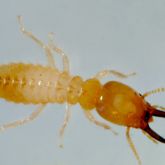Termites

Subterranean termite soldier with pear-shaped head and smooth mandibles
© Queensland Government

Subterranean termite soldier with rectangular head and serrated mandibles
© Queensland Government
Subterranean termites, commonly known as white ants, have a superficial resemblance to ants but are in fact more closely related to cockroaches. While many termite species feed on grass or decaying wood, around 10 native subterranean termite species cause damage to timber in Queensland. The most economically important and widespread species is Coptotermes acinaciformis and the most destructive is the giant northern termite (Mastotermes darwiniensis).
There are many species of subterranean termites in Queensland. Correct identification requires skill and experience. The termites need to be viewed using a hand lens or microscope of at least tenfold magnification. The size and physical structure of the soldier caste, the distribution of the termites, their nesting habits and damage all assist in identifying a species.
Termites that cause damage to houses, other buildings, furniture or other timber products are either subterranean termites or drywood termites.
Scientific name
C. cynocepalus, C. domesticus and C.dudleyi
Coptotermes acinaciformis, Schedorhinotermes species, Mastotermes darwiniensis
Other names
- Native drywood termite (Cryptotermes primus)
- West Indian drywood termite (C. brevis)
- Indo-Malaysian drywood termite (C. cynocepalus)
- Domestic drywood termite (C. domesticus)
- Giant northern termite, Darwin termite (Mastotermes darwiniensis)
Description
Subterranean termites
- Subterranean termites are generally 3–7mm long and pale brown or brown. However, giant northern termite soldiers can grow up to 13mm long.
- They usually live in the ground and need contact with the soil or some constant source of moisture. They remain within a closed system of galleries and tunnels that are devoid of light. This protects them from natural enemies such as ants, and protects them from extremes of temperature and humidity. Termites have relatively little resistance to drying out.
- They move above ground in enclosed mud galleries to infest houses and other buildings.
- Some have a central nest on the ground or in a dead or living tree.
Drywood termites
- Drywood termites do not require contact with the ground or soil moisture. They only require the moisture present in the timber, as their name suggests.
- They can infest a building through flight or the introduction of infested timber or furniture.
- Their colonies are small (a few hundred individuals) compared to those of subterranean termites.
Distribution
Subterranean termites
- Coptotermes acinaciformis – throughout Queensland
- Schedorhinotermes species – throughout Queensland
- Mastotermes darwiniensis – tropical northern Queensland and northern Australia
Drywood termites
- Cryptotermes brevis (West Indian drywood termite) – throughout Queensland
- C. primus (native drywood termite) – throughout Queensland
- C. cynocepalus – around Cairns and further north
- C. domesticus – around Cairns and further north
- C. dudleyi – Thursday Island
Hosts
Hosts include all types of timber but especially pine timbers.
The giant northern termite (Mastotermes darwiniensis) attacks growing trees, shrubs and vegetables, as well as timber in structures and products.
Timbers naturally resistant to termites include:
- native cypress pines (Callitris species)
- narrow-leaved red ironbark (Eucalyptus crebra)
- broad-leaved red ironbark (E. fibrosa)
- turpentine (Syncarpia glomulifera)
- satinay (S. hillii).
Damage
Subterranean termites
Termites create galleries in timber and trees, leading to a loss of structural integrity.
The most damaging species are:
- Coptotermes acinaciformis
- Schedorhinotermes species
- Mastotermes darwiniensis.
Drywood termites
The introduced West Indian drywood termite (Cryptotermes brevis) is the world's most destructive drywood termite. It has caused considerable economic damage to timber homes in Queensland.
Other introduced species of drywood termite causing varying amounts of damage are:
- Cryptotermes cynocepalus
- C. domesticus
- C. dudleyi.
Resources and research
Read about subterranean termites in Queensland:
- colonies
- nests
- feeding habits and behaviour
- natural enemies
- distribution
- importance.
Read about subterranean termite infestation in buildings:
- biology and damage
- how they infest buildings
- inspections
- prevention
- treating an active infestation
Read about subterranean termite baiting systems:
- baiting concepts
- termite aggregation
- commercial baiting methods.
Read about how to recognise West Indian drywood termite, including timber at risk and what to do.